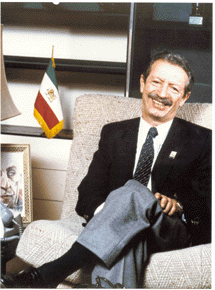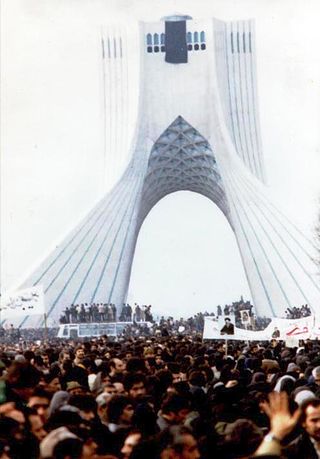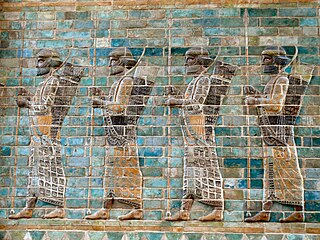This article's lead section may be too long.(October 2022) |
| 2016 Cyrus The Great Revolt | |||
|---|---|---|---|
| Part of the 2017–2021 Iranian protests, the Iranian Democracy Movement | |||
 Gatherings at Pasargadae on 28 October 2016 | |||
| Date | 28 October 2016 | ||
| Location | |||
| Methods | Demonstrations, chanting of Nationalist and Monarchist slogans | ||
| Resulted in |
| ||
| Parties | |||
| |||
| Lead figures | |||
| Number | |||
| |||
The 2016 Cyrus the Great Revolt was a pro-monarchy Iranian protest that took place at the Tomb of Cyrus the Great on Cyrus the Great Day, [1] [2] that inaugurated a series of protests with increasing calls for regime change.
Contents
The protest was triggered by rising pro-Monarchy sentiment, governmental corruption and opposition to Islamic rule, and took place on Cyrus the Great Day, at the tomb of Cyrus the Great, as a celebration of Persia's pre-Islamic glory. [3] Cyrus the Great Day, which began in the early 2000s [4] as an invented tradition on the internet and social networking websites, [5] observed by Iranian nationalists and monarchists and democrats to pay homage to Iran's pre-Islamic history, had by the mid-2010s become an unofficial holiday in Iran, being known amongst Iranians as "Cyrus the Great Day" as early as ten years prior (2006) to the protest, [6] as well as an increasingly popular and explicitly anti-government occasion.
The event fell on a Friday, which is a weekend in Iran, allowing for more people than usual to gather, and also coincided with the birthday of former Crown Prince Reza Pahlavi, who has remained a vocal figure of opposition to the Iranian government, and a symbol of support for monarchism in Iran. [6] As such, many monarchist supporters than before were inspired to turn out to the march, with people learning of the upcoming march on internet platforms such as Telegram, and reports stated that people started gathering in the Pasargadae area, especially around the Tomb of Cyrus, from as early as the evening of 27 October 2016, resulting in heavy traffic on roads to the site. In response to the large amounts of people descending on Pasargadae, the main entrance to Pasargadae was closed the night before, with no more cars allowed to enter. [7]
Despite this, on 28 October 2016, the tomb of Cyrus at Pasargadae attracted tens of thousands of people from across the country who celebrated the day and began chanting shouting slogans praising the Achaemenid king, such as. "Cyrus is our father; Iran is our country", which soon began evolving into chants of nationalist slogans criticising Iranian politics, such as "Never sleep Cyrus: Iran has no father"; "Not Gaza nor Lebanon; My life for Iran"; "I am Iranian; I do not worship the Arabs"; and "Freedom of thought cannot flow from beards." According to one eyewitness, government agents tried to drown out the chanting by blaring music from loudspeakers. [6] Pro-Shah and anti-Arab slogans were chanted, and nomads, tribesmen and ethnic minorities, including Kurds and Iranian Arabs, were also present at the celebrations in their traditional ethnic clothing. Despite the anti-Arab slogans chanted by some, a perception by many Iranians that Arab cultural dominance has entered Iran through the government's political Islam, Iranian Arabs, travelling from as far west as Khuzestan, gathered in support of the protest, chanting slogans in Arabic in support of indigenous minorities [8] and the use of their native languages, which has often been repressed by the Iranian government in favour of Persian.
The sheer number of people who showed up at Pasargadae has been described as "surprising" [7] with those who had witnessed similar get-togethers saying they had never seen such a large gathering. An unofficial 2017 estimate put the attendance figure at between 15,000 and 20,000 people, which was described as "unprecedented" according to spectators. The locals, including those living in Pasargadae village, were also "amazed" by the sheer number of visitors. [6]
As the slogans began to quickly escalate into full-scale demonstrations at Pasargadae against the Iranian government, the largest in Iran since the 2009 Iranian presidential election protests, [9] plainclothed government agents surrounded Cyrus's tomb as the crowd continued to gather, threatening people and physically attacking them in order to prevent them from getting close to the monument. Several arrests were also reported, including satirist and actor Mohammad Reza Ali Payam. [6] However, neither the police nor security forces appeared to intervene during the protest unlike previous demonstrations in Iran, [10] which created the impression to many Iranians that the government was appearing to lose its control over public discontent. This led to the revival of the protest as a means of public disobedience in Iran, after it had largely been repressed since the 2009 protests. The protest also marked the beginning of the Iranian Democracy Movement, placing its demands and its goals to the centre of Iranian politics, and placed monarchist sentiment as central to the growing anti-government opposition in Iran. As such, the protest would eventually lead to the 2017–2018 Iranian protests, which marked a significant moment in the Iranian Democracy Movement.
The Iranian government would respond to the growing perception it was unable to crackdown by jailing the event organizers and protesters as well as banning Cyrus the Great Day celebrations in subsequent years, despite illegal demonstrations continuing to take place at Pasargadae each year.
















